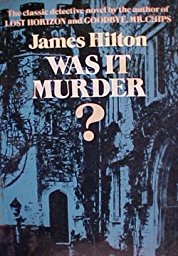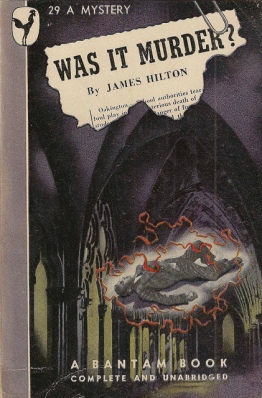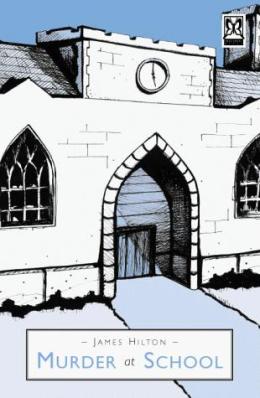Vintage Mystery Scavenger Hunt Item: Building other than a house

James Hilton is one of those writers who frequently ends up only being well known for one thing they did and in his case it is his novel Goodbye Mr Chips (1934), which has been dramatized quite a few times since in film and on TV. Was it Murder? (1931) is Hilton’s only mystery novel and was published under the penname of Glen Trevor. Like Goodbye Mr Chips this story has a mostly school setting. It begins with Colin Revell, an Oxford graduate who makes his money through article writing, whilst working on his epic satire written in iambic pentameter. At his time at Oxford he also showed some skill in resolving the odd mystery or two and it is because of that, that the headmaster of his old boarding school Oakington, has written to him to visit the school for the weekend. The headmaster wishes him to look into a death which occurred 3 months ago of a pupil called Robert Marshall. Robert died when a gas fitting fell on top of him whilst he was asleep in his dormitory. Except from getting a bit of local colour about the residents of the school there doesn’t seem to be much of a case, except for the odd behaviour of the headmaster. It was odd that Revell was even called in, but it is even odder when the next day the headmaster changes his mind and doesn’t think Robert’s death is anything but an accident.
Yet 6 months later Revell is back at the school when Robert’s older brother Wilbraham is found dead in the school swimming pool. It is assumed that he dived into the pool late at night, unaware it had been emptied for cleaning. This time around for Revell at least there seems to be a much clearer case of foul play. There is also the perfect suspect, Mr Ellington, a house master at the school, who was also the cousin of the orphaned and well off brothers. But without any real physical evidence the case seems to be another dead end for Revell. That is until Guthrie from Scotland Yard arrives on the scene… This is definitely a case which rests more on what people say than on physical clues, though Revell’s prolonged stay at the school does lead to certain suspicious facts coming out, ranging from a connection between the headmaster and Ellington to a supposed confederate holding back important information. A further tragedy seems to close the case, but Revell remains uncertain and as the book progresses, whilst the reader probably guesses the culprit early on, Revell suffice to say remains in the dark until very near the end.
As you can probably tell from the hints above this was not the strongest of mysteries. Whilst the school milieu is second to none, the mystery aspect of the plot was decidedly found wanting. Due to the nature of the investigation e.g. Revell picking up impressions of the residents of the school, as opposed to tangible evidence, the pace did begin to suffer after the first third of the book, though the injection of Guthrie into the story did help. Revell himself is also not the most satisfying of sleuths, ranging from the lovesick swain in regards to Ellington’s wife, to acting about as sensibly as a HIBK heroine. Equally Revell is a bit of Philip Trent (E. C. Bentley’s fictional amateur sleuth) and it is easy to tell when he starts veering off on the wrong track. Also like Trent, Revell’s romantic dilemmas do become a bit nauseating at times and at the end certainly raise a few questions concerning his motives. The final nail in the coffin, for me anyways, was at the conclusion of the novel when Revell does a Miss Pym (a Josephine Tey amateur sleuth who gets on my wick), running away from pain and leaping into a comfort zone which can sweep away Revell’s mental and emotional conflict. Additionally, a further characterisation problem for me was that one of the most interesting characters in the book, a school master and WW1 veteran, Max Lambourne, doesn’t appear in the story as much as I would have liked. He is probably the most complex character in the book, as well as the most amusing and it was interesting to see the different ways various people saw him, as Lambourne was definitely someone to whom a mask or persona was an essential coping mechanism.
Finally as I not so subtly mentioned earlier the guilty party is quite easy to spot, partially due to the small cast of suspects, but also because of the direction the plot takes. Revell is no Christie, which is a shame as some misdirection would have benefitted the plot no end. The final solution still has a few surprises, though one of them seems completely pointless to me, but on the whole isn’t that hard to figure out. An unsurprising consequence of the lack of physical clues in the case is that the final solution rests a lot on the confession of the criminal, something I think always tends to make a solution less satisfying.
So in a nutshell I don’t think I would really recommend this mystery unless you really love school based mysteries. It starts out well and has a great setup but the investigation format, the pace of narrative and the final solution were not as good as they needed to be. It seems Sergio, who writes the blog Tipping My Fedora had similar issues with the book (giving it an even lower rating than I did).
Rating: 3.5/5




James Hilton is one of those writers who frequently ends up only being well known for one thing they did and in his case it is his novel Goodbye Mr Chips (1934)
I’d say Lost Horizon is pretty well known, too, and it introduced the term “Shangri-La” into the language.
LikeLike
Looks like we are of like mind here! Thanks for the shout out 😀
LikeLiked by 1 person
Hmmmmm. I don’t think I’ve read a mystery set in a school that I found fully satisfying. I liked Clifford Orr’s ‘Dartmouth Murders’ for its school milieu, but wasn’t convinced that the solution played entirely fair. I liked the puzzle for Agatha Christie’s ‘Cat among Pigeons’, but wasn’t persuaded by its treatment of the school setting. I enjoyed Edmund Crispin’s ‘Love Lies Bleeding’ and Anthony Berkeley’s ‘Murder in the Basement’ – but that was irrespective of the academic milieu.
Perhaps I just have the wrong expectations: I want the novel to be Trebizon or Malory Towers, and yet boast of a fiendish crime and puzzle…! Or perhaps what we need Atticus Pund’s ‘Night Comes Calling’ to be published, with an additional resolution going beyond the one spoilt for us in ‘Magpie Murders’. 😛
LikeLiked by 2 people
hmmm it’s an idea. You’ll have to write to Horowitz and let him know! When it comes to educational settings I think I have had more success with university set mysteries. Two other school set mysteries I can think are Nicholas Blake’s A Question of Proof and Francis Beeding’s The Norwich Victims (not entirely set at the school, but is some of the time). The Blake book is okay but I’d definitely recommend the Beeding novel if you haven’t already read it.
LikeLike
I have the Beeding novel on the metaphorical TBR pile in my Kindle; I recall getting it after reading your review. I guess what’s slightly holding me back is that I tend to shy away from inverted mysteries.
Your mention of Blake’s “Question of Proof” reminded me of another school-based mystery on my Kindle: Rupert Penny’s “Sweet Poison”. Though I suppose “Sealed Room Murder” had sunk the boat between you and Penny…? 🙂
LikeLiked by 1 person
haha yeah I’m not sure I could do another Penny novel. My brain is still recovering from the last one! I know what you mean about inverted mysteries, knowing the culprit before hand can lessen the surprise. Yet in my opinion Beeding pulls off a remarkable piece of slight of hand and makes this much better than your average inverted mystery.
LikeLike
Another one for the list is Well-Schooled in Murder by Elizabeth George. I haven’t actually read it, though I’ve seen the TV adaptation.
LikeLiked by 1 person
Wasn’t aware there was school set Inspector Lynley mystery. Watched some of the adaptations but not read any of the books yet.
LikeLike
The books are pretty bloated, so far as I’m concerned.
LikeLike
haha oh well at least I haven’t been missing out on anything!
LikeLike
I should give Beeding a shot then! Currently reading a mystery manga based on Arisu Arisugawa’s novels…
LikeLike
[…] the start of the month I began with James Hilton’s Was it Murder? (1931), a less well-known school based mystery where a death which looks accidental was actually a […]
LikeLike
[…] James Hilton – Was It Murder? (1931) […]
LikeLike
[…] example of a shellshock sufferer in a Golden Age detective fiction novel is in James Hilton’s Was It Murder? (1931), where such a sufferer is made the scape goat of a series of school-based deaths, being […]
LikeLike
[…] Murder at School / Was It Murder? has been reviewed, among others, at Golden Age of Detection Wiki, Tipping My Fedora and Cross-Examining Crime. […]
LikeLike
[…] Murder at School (1931) by James Hilton […]
LikeLike
[…] Was it Murder? by James Hilton […]
LikeLike